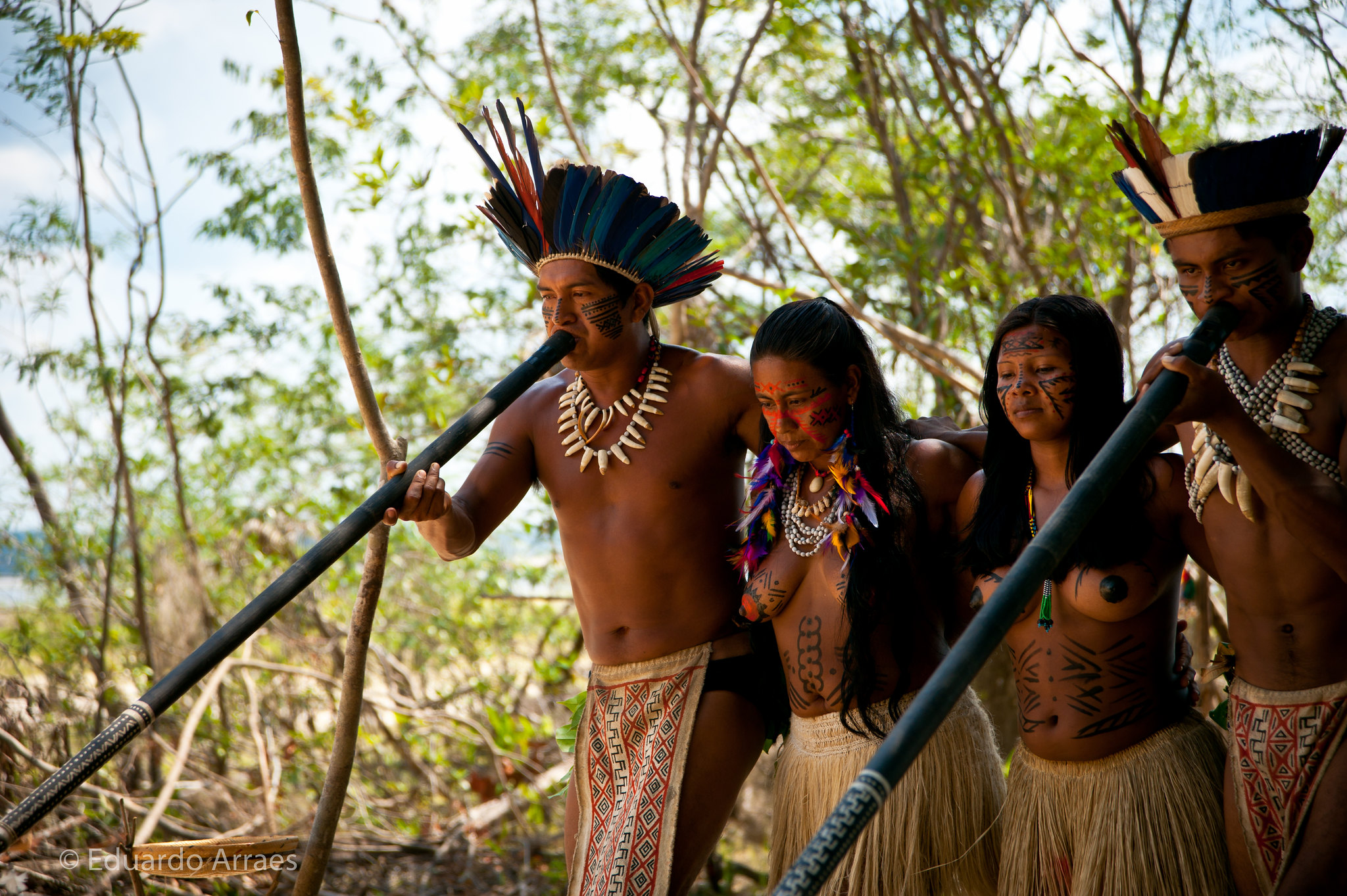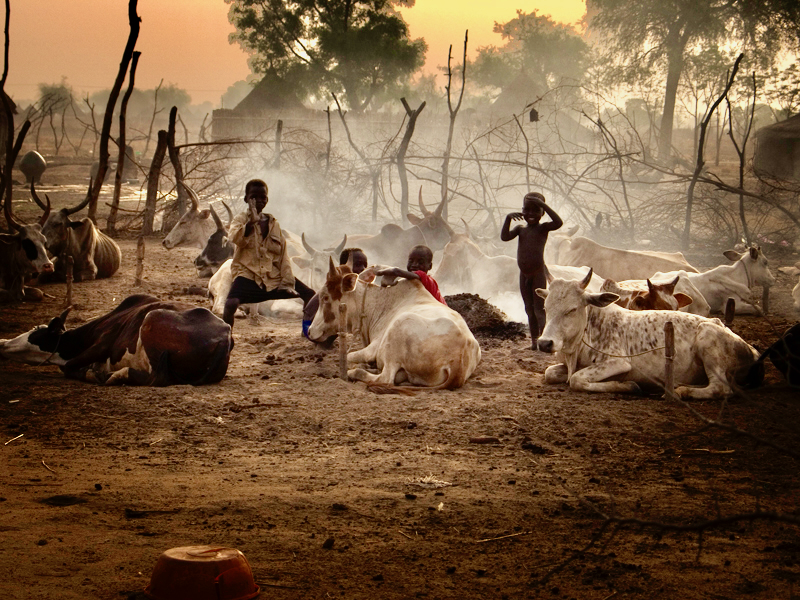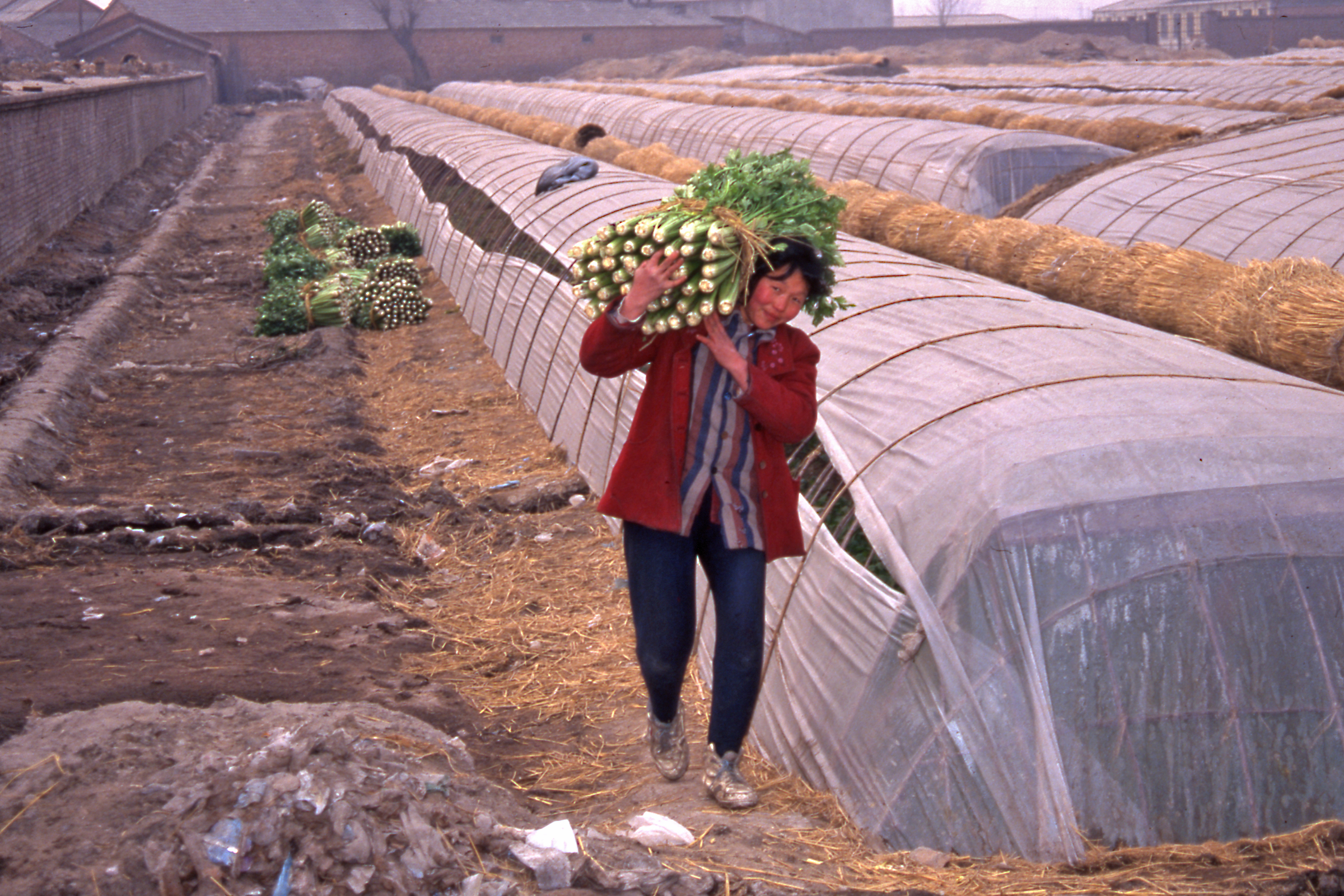The forest gives us everything we need – food, clothing, shelter, warmth and affection.
With a profound sustainability crisis facing humanity, it may be useful to try and glimpse what a sustainable relationship between people and planet might actually look like. This essay explores how cultures and their host environments mesh together in pre-industrial societies.
Professor Girardet will be speaking at the SMALL IS THE FUTURE event taking place on Saturday, 17 June 2023 at the Paintworks, Bristol. Speakers include Satish Kumar, Dr Ann Pettifor, Charlie Hertzog Young, Professor Herbert Girardet and Gareth Dale. Buy online tickets here.
It seeks to show how cultural beliefs and practices reflect and reinforce the environmental adaptations of seven different community settings – the Mbuti forest people in central Africa, the Kayapó people in the Brazilian Amazon, the Nuer cattle herders in South Sudan, the Chagga agro-foresters on Mount Kilimanjaro, Asian peasant farmers, and European small-scale urban systems.
As we face the need to limit our environmental impacts, drawing attention to pre-industrial cultures and their ecological contexts may offer some useful pointers towards a viable future.
Intimate interaction with the living world enables traditional communities to survive and to thrive. Local Nature is an existential reference point: invariably the food, building materials and firewood, their primary energy source, come from close by. Is celebrating Nature in stories, songs and community ceremonies a common trait of cultures the world over?
Mbuti cultural ecology

This is certainly true of the traditional forest-dwelling communities of Central Africa such as the Mbuti and the Baka.
They have been at home under the shelter of trees, in a world of flickering light and shade, for tens of thousands of years. Their way of life is all about interacting with the forest, the throbbing heart of their world, without degrading it.
The forest is a self-sustaining ecosystem, with minerals and organic wastes continuously recycled into humus by fungi and bacteria, insects and earthworms. The trees produce an abundance of fruit and nuts, seasonally littering the forest floor, a source of food for people and animals alike.
The forest gives us everything we need – food, clothing, shelter, warmth and affection.
These communities know the forest inside out and feel safe in it. They feed themselves without much effort, trekking through the forest on their seasonal, familiar migration routes.
They carry just a few belongings, tools and cooking utensils. As groups of maybe 40 people, they migrate and make their forest camps every few weeks, using branches and leaves for building their circular huts.
Deep familiarity with the forest’s great diversity and the skills of daily living are passed on through the generations and are echoed in cultural ceremonies.
Traditionally, the Mbuti and the Baka do not cut down trees to create space for cultivating crops. They spend a few hours every day collecting fruits, nuts, herbs, tubers and fungi, hunting monkey, antelope, warthog and sometimes forest elephants, and fishing, eating the food obtained within a day or two, and it is not elaborately processed or stored. Their tools and hunting weapons are simple but effective. They are famous for their mastery of tree climbing, particularly for harvesting honey.
The Mbuti, Baka and other forest-dwelling groups have been studied more intensely than most other tribal cultures, their lifestyle being so very different from that in the urban world we now belong to.
Even the ancient Egyptians knew about their forest way of life from expeditions down the Nile. Yet, as hunter-gatherers, they live as humans have done for 90 per cent of our time on planet Earth.
The love of the Mbuti for their Ituri forest in the Congo is vividly described by Colin Turnbull in his book The Forest People:[1]“What seems to other people to be eternal and depressing gloom becomes a cool, restful, shady world… If you have ears for it the forest is full of different sounds; exciting, mysterious, mournful, joyful…
"And the most joyful sound of all, to me, is the sound of the voices of the forest people as they sing a lusty chorus of praise to this wonderful world of theirs… [It] seems to come at you from all sides in sheer beauty and truth and goodness, full of the joy of living.”
Turnbull lived with the Mbuti for several years in the 1950s. He portrays a life full of laughter, with children growing up learning songs praising forest life – birds and mammals, berry trees, succulent roots and honeybees. They also learn songs about leopards that lurk among the trees, with human and leopard respecting each other: they know about the leopard’s fearsome teeth, and the leopards know about their bows and poison arrows.
Turnbull spent much time recording the Mbuti’s remarkable communal music involving complex contrapuntal polyphony.[2] Music and dance are an integral part of their lives, celebrating the inauguration of new encampments, hunting expeditions and funerals, or just for entertainment. He describes the Molimo ceremony – a festival in which the Mbuti praise the goodness of the forest.[3]
One interviewee told him: “The forest is a father and mother to us… It gives us everything we need – food, clothing, shelter, warmth … and affection… So when something big goes wrong … it must be because the forest is sleeping and not looking after its children… We wake it up by singing to it… Then everything will be well and good again. And when our world is going well then also we sing to the forest because we want it to share our happiness.”[4]
These descriptions are also echoed by Phil Agland in his TV documentaries on the Baka tribe in the rainforest of Cameroon.[5]
Frederick Wangabo, director of East and Central African Association for Indigenous Rights, himself from a forest-dwelling tribe, says this: “We should look how the [forest people] take the forest as a personal god. If you talk to any [forest person] they will say that we should look at how they sustain the forest…
"If you destroy the forest you never protect the [forest people], because they are not really people without the forest. Any [forest person] will tell you: my god is the forest.”
There are currently believed to be around 120,000 forest-dwelling people in the Congo, Cameroon, Rwanda, Burundi, Zambia and Gabon, known by ethnic names such as Mbuti, Efé, Baka, and Asua.
They are among the world’s last surviving hunter-gatherer cultures, and their forest habitat is under pressure from logging, from neighbours demanding land for farming and herding, or from mining companies seeking to enslave them for extracting minerals from below the forest soil.[6]
In his groundbreaking book Stone Age Economics, US anthropologist Marshall Sahlins asserted that hunter-gatherers are the “original affluent society”, with the word ‘affluence’ defined not as acquired wealth, but as lack of want.[7] Unburdened by the pursuit of material goods, they meet their needs with relative ease, enjoying abundant leisure.
The forest-dwelling peoples’ nomadic way of life is shared by other hunter-gatherer cultures, such as the Bushmen of the Kalahari, the Hadza in Tanzania, and the Aboriginal peoples of Australia.
A leading Aboriginal voice was Yunupingu, who died in March 2023. He said this about his people’s egalitarian culture and its sense of generational continuity: “We seek that moment in the ceremonial cycle where all is equal and in balance.
"Where older men have guided the younger ones and, in turn, taken knowledge from their elders; where no one is better than anyone else, everyone is equal, performing their role and taking their duties and responsibilities – then the ceremony is balanced and the clan moves in unison: there is no female, no male, no little ones and no big ones; we are all the same.”[8]
From Central Africa to Amazonia
Central Africa’s forest-dwelling hunter-gatherer communities are not alone in their deep attachment to a tropical forest world. Amazonia, of course, has its own forest people as well: tribes such as the Yanomami, Asháninka, Arara, Kayapó, Cinta Larga and Assurini.
They, too, are long-standing forest dwellers, gathering, hunting and fishing, but they are also ‘slash-burn’ forest farmers: they clear small patches of forest at a time to grow manioc, beans and bananas in the ash of small-scale fires.
They remove only a few acres of forest for their gardens every year, thereafter letting the forest regrow, enriched with newly planted fruit and nut trees.

The study of forest people, who were once called ‘primitives’, ‘uncivilised barbarians’, has opened up new perspectives of the innate capacities of the human mind. Forest people are finally being recognised as guardians of some of the world’s most complex ecosystems.
They truly understand the ‘law of the jungle’, but it is not the cut-throat world that this term still implies. In their world, living beings coexist in an immensely complex, interdependent web of life, including the forest people themselves.
They are now finally being seen as the experts of their green world, and of the medicinal uses of plants. Ethnobiologists who studied with shamans of various Amazonian tribes found that they had a word for every plant in the forest, and a use for most. And why not? They have been living in the Amazon for tens of thousands of years, long enough to experiment with innumerable plants for nutrition and medicine.[9]
Ethnoecologist Darrell Posey, working with the Kayapó in the Brazilian state of Pará for many years, pioneered an understanding of the ecological dimensions of Amazonian cultures.
In his book Kayapó Ethnoecology and Culture he summarises his findings: “The Kayapó see the processes of the universe and life as cyclical. Plants, animals and people are all manifestations of the same dynamic energy.
"The Kayapó strive for a harmony with other elements of the universe, and sickness occurs when the balance of man and nature is upset. The overall balance between natural forces is maintained by performance of a complex cycle of rituals and ceremonies.
"These include singing and dancing and involve all Kayapó. Each individual, therefore, is directly involved in maintaining the harmony of life, and is an agent in the perpetuation of ecological stability and the well-being of self and society.”[10]
Meanwhile the Kayapó and other Indigenous communities are finding their own voices in defending their forest cultures. Mayalú Txucarramãe, a granddaughter of famed chief Raoni Metuktire, says this: “Our survival is the survival of the forest, and the survival of forests is the survival of the planet.
"We’re on the edge. But until the end, we will be the resistance… My grandfather said long ago that the uncontrolled action of man has unbalanced nature. Fish are dying because the rivers are drying up, and this has harmed forests, too. The cycle of rainfall is not the same, which affects the plants and animals… Then I see that nature is crying, and it is as if my grandfather is crying… For me, caring for nature is caring for my ancestors.”[11]
Forest cultures have a great deal to teach us about utilising biological resources intelligently. The plant knowledge of Indigenous cultures of the Americas has originated a vast range of staple food crops such as maize, potatoes, avocados, tomatoes, manioc, bananas, beans and chilli. And could some of their plant remedies help with fighting diseases afflicting the world today?[12]
The Amazonian tribes, like the forest people of central Africa, tell us that they cannot survive without the forests, which provide them with everything they need to live.
These sentiments are clearly expressed by the Indigenous leader of Brazil’s Forest Peoples’ Alliance, Ailton Krenak: “All the knowledge of our forest people is based on a permanent relationship with the places in which they live.
"The people who live in one valley see rivers and mountains in a very different way from a geologist or a biologist. A mountain for us has a name, has children, has loves, has a history, has a story to tell because it has witnessed life passing.
"Our songs, the ceremonial songs, the healing songs, the war songs, were all gifts from the forest. They were given to us by the animals, the water, the wind: the author and composer was Nature.”
These words could also be those of forest people in Africa, Malaysia, Indonesia, the Philippines or Papua New Guinea. They all share a great love for their green world, something that is difficult to understand for people who are not familiar with the forest.
The Bantu people on the verges of the Congo rainforest, for instance, have been encroaching on these forests to establish pastures and farmland for centuries. They are intimidated by the forest and do not know how to make their living from it.
The same is true of the ranchers who have been clearing the Amazon rainforest to supply expanding markets for beef across the world. In Brazil alone over 25 per cent of the forest has been incinerated in recent decades to establish cattle ranches and, more recently, soybean farms.
The newcomers regard the forest as a green hell, a land that is underutilised and that must give way to their extractive enterprises. Unfortunately, cattle ranches established on fragile tropical forest soils often become infertile after only a few years, and where there was pristine rainforest only useless scrub remains.
Forest people across the tropics are now threatened as never before from logging, mining, dams and agricultural development. And as more roads are built and more forest is incinerated, they are exposed to deadly new diseases.
The advance of modern civilisation has taken a terrible toll on the Amazonian tribes: numbering six or seven million before contact, today only some 250,000 remain. More about this in my Amazonia Ablaze essay, published at The Ecologist.[13]
A herding way of life

It is not only forest people who cherish and make sustainable use of their customary environments. The eminent British anthropologist Edward Evan Evans-Pritchard wrote a pioneering cultural-ecological study about an African cattle-herding people, the Nuer, who live on the grasslands of South Sudan.
They, too, think that theirs is the world’s finest land, even as outsiders might see only a monotonous savannah and marsh landscape. Like many other African cattle-herding cultures, the Nuer have been practising their way of life for hundreds or even thousands of years.
Their lands are much better suited for grazing than for farming: Humans cannot thrive on grass, but cattle can. Cows’ milk is the Nuer’s main source of food.
Nuer life is seasonal: in the dry season, the younger men take their herds to graze across large, traditional territories. In their dry-season camps, the men sleep with their cattle in shelters made from mud and grasses.
In the rainy season, as the local rivers flood, the people move onto higher ground, where the women cultivate millet and maize, and men herd their cattle on nearby pastures. Extended family groups live in camps consisting of round houses with mud walls and thatched roofs.
Evans-Pritchard described the relationship between the Nuer and their cattle: “Cattle and men sustain life by their reciprocal services to one another.
"In this intimate symbiotic relationship, men and beasts form a single community of the closest kind. The men wake about dawn in the midst of their cattle and sit contentedly watching them until milking is finished.
They then either take them to pasture and spend the day watching them graze, driving them to water, composing songs about them, and bringing them back to camp. Or they remain in the kraal and drink the milk, make tethering cords and ornaments for them, water and in other ways care for their calves, clean the kraal, and dry the dung for fuel. When the cattle return in the evening, they tether each beast to its own peg with cords made from the skins of their dead companions.
"A man knows each animal of his herd … its colour, the shape of its horns, its peculiarities, its history, its ancestry, and its progeny.”[14]
The Nuer have an animistic worldview, but they worship a supreme being called Kwoth. They pray for health and wellbeing of people and animals, offering sacrifices to Kwoth. There is no organised religious hierarchy, but many individuals serve as diviners and healers.[15]
Cattle are the great love of people like the Nuer and their neighbours the Dinka – they sing elaborate songs to their favourite cows and name their children after them.
Children learn from infancy how to look after the animals, how to milk them, and how to protect them from raiders or wild animals. To own cattle means to be wealthy, and some Nuer are wealthy even in comparison with cattle ranchers in today’s Amazon, but unlike these cattle ranchers, people like the Nuer live in harmony with their local environment, not in a destructive, downward spiral.[16]
Alpine pastoralist culture
Sustainable cattle-raising cultures can still be found in many regions in the world, not just in lowland areas, but also in mountainous regions like the Alps.
In Switzerland, Bavaria, Austria and the French and Italian Alps, cattle raising has been going on for centuries. As a child I often spent summer months in the Allgäu mountains in Bavaria, witnessing the life of the mountain farmers there.
In late spring the cattle are herded from their winter homes beside the valley farmhouses up to rich mountain pastures, where they spend the summer months. The ringing sound of their bells is ever present, the lead cows carrying the largest bells.
These older cows, who know the mountain pastures best, can sometimes prevent inexperienced, younger animals from grazing too close to dangerous rock cliffs.
The mountain farmers are very skilled at maintaining the fertility of the Alpine pastures. They collect manure from the lowland cowsheds during the winter months and truck it up to the mountain grassland.
They follow well-established conventions for keeping the steepest slopes covered in forest to prevent soil erosion. And the huge farmhouses in the valley, with cowsheds attached, are built of timber from the hillsides, the trees also providing firewood.
Throughout the summer, the farmers make cheese in their mountain huts, and in the autumn, when the grass stops growing, they herd the cows back down into the valley.
The cows’ horns are decorated with ornate garlands, and the premier cows with the largest bells take the lead in the great procession down from the mountain. I have watched the arrival of such herds in their home villages. The cows seemed to know the farmhouses to which they belonged, heading straight back to the familiar stables where they would spend the winter months.
The return of the cows to the villages would be followed by elaborate celebrations, with dancing, singing, eating and drinking in local bars, the whole village coming together in an exuberant affirmation of a shared lifestyle. Today such celebrations are well-publicised spectacles all over the Alps, increasingly aimed at tourists and their money.[17]
The food forests of the Chagga
In the search for sustainable land use systems, tropical agroforestry has become another important subject of study. This type of multi-storey food production system has many agronomic benefits: it combines tree cover with staple food supplies, cash crops and animal husbandry, whilst also assuring minimal soil erosion and carbon sequestration.
Some years ago I had the opportunity to visit and to film in the Chagga home gardens on the southern slopes of Mount Kilimanjaro in Tanzania. Today these gardens attract much scientific attention, as their system of cultivation is seen as of great relevance to hilly areas throughout the tropics.
The Chagga moved into the lush mountain forests several hundred years ago. They felled some of the trees, and under the newly opened canopy they planted a great variety of crops. The trees they cut down provided timber for houses, and sheds for cows and goats.
Walking around the Chagga’s food forests, we were in a green world, surrounded by leaves of many different shapes. The sky shone through the crowns of the big trees. Further down, all around us were fruit and nut trees and banana bushes. We were told that fifteen kinds of banana were being cultivated.
Between them, coffee bushes had been planted, and at ground level vegetables grew in abundance. We were in a human-made food forest, with houses, huts and animal shelters scattered among the trees and bushes. Everywhere crops were being grown. Most of the Arabica coffee produced in Tanzania comes from these gardens.
Today the Chagga land use system is attracting much scientific attention because it is seen as highly relevant to hilly areas throughout the tropics. The gardens support the highest population density in Tanzania, with some 1,300 people per square mile.
The Chagga cultivation system is virtually self-sustaining. The tall forest trees provide the food crops with shade from the fierce tropical sun. Their leaves provide some fodder for the farm animals, and mulch to cover the soil.
In addition, they supply fruits, nuts, medicines, timber and firewood. Their roots prevent the soil from being washed down the mountainside. Each home garden has a network of irrigation furrows, which are fed with water from the mountain glacier. The water supply is managed cooperatively and is rotated between smallholders according to their needs.
Before the arrival of Europeans, the Chagga worshipped a creator god called Ruwa, who was believed to reside atop the sacred mountain Kilimanjaro, source of the water used for irrigating the home gardens.
The great sophistication of the Chagga agroforestry system is now widely acknowledged as a remarkable example of applied ecology. As one of the many variants of agroforestry or permaculture, it offers a promising approach to long-term food security for people throughout the tropics.[18]
With increasing populations, sustainable systems of cultivation that are not reliant on mineral fertilisers and chemical pesticides are being rediscovered and further developed, not just in Africa, but also in India, Thailand, Malaysia, Indonesia and Brazil.

The Chagga home gardens are found on Mt. Kilimanjaro in northern Tanzania.
Asian peasant farmers

The natural world has long been conceived in Chinese thought as a self-sustaining, complex arrangement of interacting forces. Taoism instilled in Chinese people a deep respect for Nature, as did Shinto culture in Japan, and Sansin Nature worship in Korea.
Farming, by definition, is an artificial activity – establishing the human presence on specific plots of land, often to the detriment of other living species. But well-thought-out farming systems can exhibit a considerable degree of environmental stability.
In many parts of the world, small-scale farming has long been a dominant, sustainable way of life if not disrupted by population growth or loss of land to development. Traditional peasant farmers tend to have well-established concepts of trans-generational continuity, and their cultures reflect this.
The American agronomist Franklin Hiram King was keen to find out how, after thirty or even forty centuries of cultivation, the soil of farms across Asia could produce sufficient food supplies for large populations.
In his book Farmers of 40 Centuries, published in 1911, he writes: “We have now had this opportunity and almost every day we were instructed, surprised and amazed at the conditions and practices which confronted us whichever way we turned; instructed in the ways and extent to which these nations for centuries have been and are conserving and utilizing their natural resources, surprised at the magnitude of the returns they are getting from their fields, and amazed at the amount of efficient human labor cheerfully given for a daily wage.”[19]
King goes on to describe organic farming practices in China, Korea and Japan, and how they were based on sustainable give and take between farming families and the land they utilised.
Traditional practices included legume crops for nitrogen fixation, crop rotations and intercropping, terracing and the use of diverse, locally adapted crop varieties. Human, animal and crop wastes were systematically recycled to maintain soil fertility.
In his introduction, King summarises the key systemic principles: “Almost every foot of land is made to contribute material for food, fuel or fabric. Everything which can be made edible serves as food for man or domestic animals.
"Whatever cannot be eaten or worn is used for fuel. The wastes of the body, of fuel and of fabric worn beyond other use are taken back to the field; before doing so they are housed against waste from weather, compounded with intelligence and forethought and patiently labored with through one, three or even six months, to bring them into the most efficient form to serve as manure for the soil or as feed for the crop.
"It seems to be a golden rule … that whenever an extra hour or day of labor can promise even a little larger return then that shall be given, and neither a rainy day nor the hottest sunshine shall be permitted to cancel the obligation or defer its execution.”
As King points out, this meticulous system of farming based on nutrient and carbon cycling has maintained soil fertility and structure over forty centuries or more. The farmers grow small quantities of food, mainly rice and vegetables, for their family’s needs on a few acres of land.
They also usually have a surplus for sale. They only use human and animal muscle power, maintained by the food grown on their land. This circular metabolism enables them to keep their land fertile, generation after generation, assuring continuity of family and community life.
In a world increasingly dominated by large-scale farming systems based on artificial inputs of agri-chemicals and modern machinery, such traditional farming systems are of the greatest relevance today. This applies as much to agroforestry cultivators as to Asian peasant farmers like those described by King.
Human settlements and their hinterland

Across the world, the wellbeing of people is closely linked to sustainable land use. This is also true regarding the linkages between villages and towns and their surrounding countryside.
In his book The Isolated State, published in 1826, the German geographer Johann Heinrich von Thünen describes how traditional European villages or towns, in the absence of major transport systems, utilised their local landscape.[20]
Von Thünen’s model encompasses four concentric rings of agricultural activity surrounding the settlement. The first ring, closest to the town, accommodates horticulture and dairying, since vegetables, fruit, milk and dairy products must get to market quickly.
The second ring is for timber and firewood: heavy materials that are difficult to transport over longer distances. The third ring consists of extensive field crops such as grain that can be stored in granaries. The final, most distant ring is used for ranching and rough grazing. Beyond this fourth ring lies common land for grazing sheep and goats tended by shepherds.
Von Thünen saw these arrangements as a function of three factors: the cost of transport to market, the cost of keeping soil fertile, and the land rent farmers could afford to pay.
The different circles of crops surrounding towns and villages have different needs of cultivation, protection, and the maintenance of soil fertility. Soils in the first ring, where the most valuable crops are grown, require regular manuring. Further away from the settlement, perennial crops like fruit trees and vines need less frequent attention, mainly in the spring and during harvest time.
In the 1980s I filmed in Dinkelsbühl, in Franconia, one of the few traditional market towns in Germany still surrounded by a largely intact, protective town wall. Its agricultural belts were still much in evidence.[21]
Similar cultivation systems have been in existence all across the Mediterranean. A British geographer, Michael Chisholm, studied long-established village land-use patterns in various countries across the world.
Regarding the La Mancha region in Spain, he quotes research describing intricate arrangements for different crops around village locations, arranged in concentric circles: "On a terrain which is almost perfectly homogeneous…
"The pattern of settlement and land use is remarkably geometric. In the middle of the nude plain there are enormous villages… Around the villages, the bare fields on the one hand and the olives and vines on the other are disposed in concentric circles.
"The latter crops … generally are not found nearer the village than 3 or 4 kilometres. There is a third and outer ring, the uncleared land abutting on the surrounding hills … devoted to grain and tree crops according to the needs of the population and the state of the market.”[22]
It is important to realise that a sustainable relationship between settlements and local landscapes assured stable cultures, which in one way or another existed for millennia. At a time of climate change and increasingly expensive long-distance transport, can we move towards more local ways of living once again?
Conclusions
One aim of this essay was to establish that, traditionally, in communities with only minimal outside interference, land use and culture are closely interwoven.
Left to their own devices, tribal and village communities invariably built ‘eco-active’ cultures, in balance with Nature’s regenerative capacity.
This applies equally to forest dwellers like the Mbuti and the Kayapó, cattle herders like the Nuer, Alpine mountain farmers, agro-foresters like the Chagga, peasant farmers in India, Korea and China, and traditional agro-urban communities.
There is much to learn from such long-established practices as we face a climate and biodiversity emergency. In their varied ways, they are all defined by a balanced give and take between themselves and their local landscapes. They all source their existential supplies from the soil rather than from subterranean resources.
In the last 80 years, fossil fuel technology has profoundly changed how we feed ourselves, disregarding local sources and bringing in food and other vital necessities from far away.
In northern Europe, most fruits and vegetables are now trucked long-distance – from Italy, Spain or Morocco. The grains and pulses used for animal feed, pasta or bread are mostly shipped across the Atlantic, from the US, Australia or Canada, or from Brazil.
Timber comes from the very places tropical forest dwellers call home, as well as from far-away temperate forests. Our environmental impacts are now on a global scale, but we are only just starting to face up to the long-term consequences.
What can we learn from traditional practices? Over millennia, humanity has developed a tremendous range of lifestyles, adopting a wide variety of environmental options.
Today this is more evident than ever before. For instance, a Chinese peasant farmer on a few acres of land is very different from a Kansas wheat farmer on 1,000 acres, who is backed up by a complex array of technologies – diesel-fuelled farm machinery, pesticides and fertilisers – originating from distant factories, requiring metals, chemicals and energy in their manufacture.
The bulk of the Kansas farmer’s harvest is sold to distant markets, helping to pay for all this technology. Soils are kept productive, not by recycling organic waste, but by mineral fertilisers, some of which leach into groundwater, streams and rivers, and the ocean beyond.
Pesticides, used to deal with the wide range of pests found in monocultures, also end up as soil and water pollutants. Private profits increase as public costs rise. The fact is that contemporary land use systems are subsidised by massive injections of fossil energy.
In her book Soil Not Oil, Vandana Shiva writes: “An analysis of energy in the US food chain found that, on average, it takes 10 calories of energy to produce one calorie of food. … Part of this wasted energy is going into the atmosphere to contribute to climate change…
"Industrial agriculture in the US uses 380 times more energy per hectare to produce rice than a traditional farm in the Philippines… Energy use for corn production in the US is 176 times more per hectare than on a traditional farm in Mexico…”[23]
Nevertheless, a worldwide survey of farmers will probably reveal that the Kansas wheat farmer on 1,000 acres is a global model to be emulated, not the Chinese peasant on three acres.
But in contrast to the agricultures of our predecessors, we have broken all the rules of sustainable living. In the never-ending march of progress, we have thrown overboard long-held notions of environmental security, and the resulting resource depletion, pollution and eco-systems damage are ever-growing concerns.
There is no doubt that we need to rethink our current notions of both energy and land use. Traditional practices have much to teach us. Whilst smallholders still produce a third of the world’s food, often achieving higher yields per acre than highly mechanised farms, they are frowned upon because of lower labour productivity.[24]
Can we build a contemporary ecological agriculture? And, as part of this, can we replace our systemic dependence on fossil fuel energy technology with an all-out effort at mainstreaming renewable energy?[25]
If we are to build an ecological civilisation, we need to venture beyond short-term thinking and explore how culture and environmental regeneration can come together for a new sense of continuity. What does it mean to be custodians of life on Earth?
It is unlikely that many of us will lead the lives of forest people as we look ahead. But traditional forest-dwelling communities have every right to continue with their long-established lifestyles.
Meanwhile there are many initiatives across the world to revive and introduce small-scale, ecologically adapted land use systems – under the headings of permaculture, agroforestry and regenerative agriculture. In one way or another they are all circular systems, based on nutrient and carbon recycling, as indicated in the case studies in this essay.
Throughout history, eco-cultural feedback systems have enabled people to continually adjust their lifestyles to ensure long-term continuity. Could we achieve such a sense of continuity today, but on a global scale?
More than ever, we need a global ecological communications network, conveying the plurality of local options for regenerative living, and indicating what we can or cannot do to the Earth if we wish life to continue in all its immensely rich variety.[26]
This Author
Professor Herbert Girardet is a co-founder of the World Future Council, and a member of The Club of Rome. His most recent book is Creating Regenerative Cities (Routledge). Professor Girardet is also a trustee at the Resurgence Trust, which owns and publishes The Ecologist.
Professor Girardet will be speaking at the SMALL IS THE FUTURE event taking place on Saturday, 17 June 2023 at the Paintworks, Bristol. Speakers include Satish Kumar, Dr Ann Pettifor, Charlie Hertzog Young, Professor Herbert Girardet and Gareth Dale. Buy online tickets here.
Notes
[1] Colin Turnbull, The Forest People, Chatto and Windus, 1961
[2] Historic recordings of Mbuti music made by Colin Turnbull: https://www.worldmusicstore.com/products/music-of-the-rainforest-pygmies-historic-recordings-of-colin-turnbull-cd
[3] https://www.song-bar.com/lyric-word-of-the-week/word-of-the-week-molimo-mbuti-pygmy-music
[4] https://www.youtube.com/watch?v=3zdazJ0X1nc; https://www.facebook.com/Mesmerizingsounds/videos/pygmy-song/476385725889534/
[5] ‘Baka – Growing Up’. Episode of the 1987 documentary series Baka – People of the Rainforest. https://www.youtube.com/watch?v=HwhD3-xcAa4
[6] https://www.youtube.com/watch?v=3DwFIq8mWTI
[7] Marshall Sahlins, Stone Age Economics, Aldine-Atherton, 1972
[8] https://www.theguardian.com/australia-news/2023/apr/03/yunupingu-yolu-leader-and-campaigner-for-indigenous-rights-dies-aged-74
[9] Herbert Girardet, Amazonia Ablaze, 2022, https://theecologist.org/2022/aug/19/amazonia-ablaze
[10] Darrell A. Posey, Indigenous Knowledge and Ethics: A Darrell Posey Reader, Routledge, 2004
[11] https://amazonwatch.org/news/2022/0303-portraits-of-women-defenders-uniting-across-the-amazon
[12] https://www.conservation.org/projects/brazils-kayapo-stewards-of-the-forest
[13] https://theecologist.org/2022/aug/19/amazonia-ablaze
[14] Edward E. Evans-Pritchard, The Nuer: A Description of the Modes of Livelihood and Political Institutions of a Nilotic People, Clarendon Press, 1940
[15] http://orvillejenkins.com/profiles/nuer.html
[16] https://www.youtube.com/watch?v=ksTxz3yrdcQ
[17] https://www.dw.com/en/mountain-traditions-costumed-cattle-parade-in-the-alps/video-63380050
[18] https://www.youtube.com/watch?v=JFaRs8L8QnY
[19] Franklin Hiram King, Farmers of Forty Centuries: Organic Farming in China, Korea and Japan, Mrs F.H. King, 1911
[20] Johann Heinrich von Thünen, Der Isolirte Staat in Beziehung auf Landwirthschaft und Nazionalökonomie, Friedrich Pertes, 1826
[21] Herbert Girardet, The Metabolism of Cities, 2023, https://theecologist.org/sites/default/files/2023-03/Megamorphosis-Cities-FINAL.pdf
[22] Michael Chisholm, Rural Settlement and Land Use, Hutchinson, 1962
[23] Vandana Shiva, Soil Not Oil: Climate Change, Peak Oil and Food Insecurity, Zed Books, 2016
[24] https://ourworldindata.org/smallholder-food-production
[25] Herbert Girardet and Miguel Mendonça, A Renewable World: Energy, Ecology, Equality, Green Books, 2009
[26] Herbert Girardet Biosphere and technosphere, 2022, https://theecologist.org/2022/nov/28/biosphere-and-technosphere







